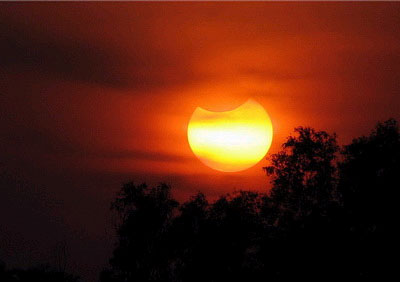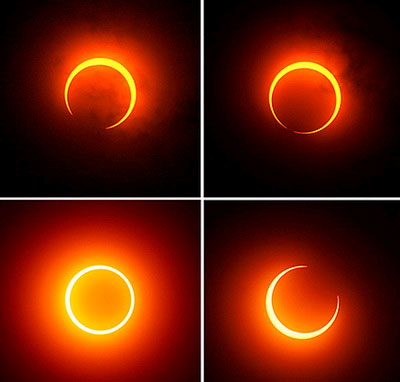Watch the annular eclipse
The afternoon of January 15 will take place the annular eclipse, an interesting natural phenomenon. In Vietnam, a solar eclipse can be observed in the period from 14h15 to 17g.

Japanese real-world advice on January 26, 2009 - Photo: Amateur astronomical club Ho Chi Minh City

Japanese real picture recommended shooting in Indonesia on January 26, 2009 - Photo: National Geographic
The Northern region will see the most eclipse with a greater coverage than 60%. In the Central region, the sun's obscurity is about 40-60%.
In the southern provinces, the sun's obscurity is reduced by only 30-40% but still many times larger than the solar eclipse of July 22, 2009.
Solar eclipse takes place at the time of the Sun, Moon and Earth alignment. Because the distance between the Moon, the Earth and the Sun is not fixed, sometimes the Moon does not cover the Sun, creating an annular eclipse. At that time, the Sun still appeared as a brilliant ring around the Moon.
The next solar eclipse will take place on July 11, 2010 but only observed in the South Pacific. In Vietnam, since the solar eclipse on 21-5-2012 is very difficult to see (only takes a few minutes in the early morning), it is not until 9-3-2016 that we can review the eclipse partially and until The total solar eclipse will be visible in 2070.
In Ho Chi Minh City, the Ho Chi Minh City Astronomical Club will hold an annular solar eclipse observation at Children's House Q.5 (No. 109 Ngo Quyen, Ward 11, District 5), starting at 2pm. Viewers will be observed eclipses through telescopes and dedicated solar observation glasses.
In Hanoi, Hanoi Astronomical Society - HAS will organize a focused observation at My Dinh stadium; In Da Nang, Polytechnic Astronomical Club - PAC will organize observations at Pham Van Dong beach.
Observe safe eclipse:
When solar eclipse takes place, it is very dangerous to see with the naked eye because sunlight can damage and reduce eyesight permanently. For direct observation, it is necessary to use specialized solar eclipse glasses or welders with a darkness of 12 or more.
Other materials such as sunglasses, X-ray films, photographic films . are recommended by scientists not to use even though it can reduce the glare of the Sun but can still give off many harmful radiation rays such as piercing the eyes.
If there are no directly observed materials, we can observe indirectly in the following ways:
- Create a small hole of about 1mm on a piece of cardboard or a sheet of metal, let the sun penetrate and observe the image of the Sun through the hole in a white sheet placed below.
Alternatively : look at the image through a mirror that is completely submerged in the bottom of the ink bath, tilting towards the Sun. The phase must ensure the sun is calm without glare.
- If you have telescopes or binoculars, do not see the Sun directly without a dedicated filter. We can observe by pointing the lens towards the Sun and lighting the light on a sheet of paper placed behind.
- Sino-Japanese-Americans will witness an eclipse of the annals
- A guide to observing the solar eclipse of the day on May 21
- Vietnam will watch an annular solar eclipse on May 21
- The world welcomes the sun's ring, the moon in the middle of the year 2017
- Video: The coronary eclipse recommended in Australia
- Vietnam did not observe the first solar eclipse of the year
- The world of eclipse eclipse glows with a circle of fire
- Rare real Japanese swept across 3 continents
- The world sees annular eclipse
- See eclipse images taken from satellites
- Amazing phenomenon - the annular fire ring glows in the sky on September 1
- Overview of solar eclipse this morning in Vietnam and Southeast Asian countries
 Van Allen's belt and evidence that the Apollo 11 mission to the Moon was myth
Van Allen's belt and evidence that the Apollo 11 mission to the Moon was myth The levels of civilization in the universe (Kardashev scale)
The levels of civilization in the universe (Kardashev scale) Today Mars, the sun and the Earth are aligned
Today Mars, the sun and the Earth are aligned The Amazon owner announced a secret plan to build a space base for thousands of people
The Amazon owner announced a secret plan to build a space base for thousands of people